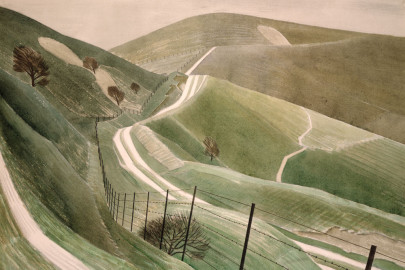W.G. Hoskins’ The Making of the English Landscape, first published in 1955, has in many ways been overtaken by later studies, but is still the classic of its subject – and is undoubtedly the best written.
Hoskins is animated by a love and deep, intimate knowledge of certain local landscapes – especially those of Devon and Cornwall, the Midlands and north Oxfordshire – and by nostalgia for the things he saw as being lost to ‘the lunacy of the 20th century’, with its ‘foul and joyless towns’ and its new roads, ‘treeless and stinking of deisel oil, murderous with lorries’. In the Midland countryside, he hears ‘the dull roar of a fast main-line train taking people from a dismal illiberal life in Birmingham to a dismal illiberal life in London’.
A thoroughgoing reactionary (he was against, among other things, ‘income-tax, hydrogen bombs and the relentless onward march of science’), Hoskins clearly believed that England lived through a kind of golden age, between about 1570 and 1770, when the long battle to clear and colonise the land was won, parliamentary enclosure and factory industrialisation were yet to come, and ‘men lived in a place that had meaning and significance for them’. Well, maybe – and surely this is still true of some men in some places (I certainly feel it’s true of me, rooted for half a century in my suburban demiparadise)…
Hoskins’s great insight is that landscape can only be understood when viewed in four dimensions. Time is what gives it depth and brings it fully to life, and Hoskins sees that, in the end, ‘Everything is older than we think’ – a truth that all who look back on earlier ages, especially the more remote ones, would do well to bear in mind.
Here is a passage, not from The Making of the English Landscape, but from a later essay, that sums up the rich rewards – the necessity even – of looking closely at a landscape and reading it, knowing it in all its historical depth:
It is satisfying to sit upon a Saxon boundary bank that commands a view of perhaps three or four miles, no more, near enough for everything to be seen clearly, and to be able to give a name to every farm dotted about the fields, to every wood and lane, to know which of these farms is recorded in Domesday Book, and which came later in the great colonisation movement of the 13th century; to see on the opposite slopes, Georgian stucco shining in the afternoon sun, the house of some impoverished squire whose ancestors settled on that hillside in the time of king John and took their name from it; to know that behind one there lies the ancient estate of a long-vanished abbey where St Boniface had his earliest schooling, and that in front stretches the demesne farm of Anglo-Saxon and Norman kings; to be aware, if you like, that one is part of an immense unbroken stream that has flowed over this scene for more than a thousand years; but at any rate to look at every feature with exact knowledge, able to give a name to it and knowing how it got there, and not just to gaze uncomprehendingly at it as a beautiful but silent view.
To read Hoskins is truly to have your eyes opened, and I’d urge anyone who hasn’t got round to it to put him on your ‘to read’ list. As well as the Pelican paperback edition, available for 1p from Amazon, the Folio Society publishes a handsome edition, slipcase and all.












I agree, Nige, this is a classic of its genre – a superb study of our inheritance that beautifully evokes all that is precious about the English countryside. I’d describe the genre as ‘historical geography’. One of the greatest British writers on this subject, pre-dating Hoskins, was H C Darby. I notice that Ronald Blythe’s Akenfield is also available on Amazon for 1p.
Oh yes – do you know, I’ve never read Akenfield – I must!
If I didn’t already have this book, I would buy it simply because of your review, which captures its essence beautifully. The book is a wonderful read. In the final chapter Hoskins spits out contempt for the landscape of mid-fifties England then, prior to the books almost elegiac final pages, he states ‘…let us turn away and contemplate the past before all is lost to the vandals’, he then concludes with an evocative description of the world that lies within the view from the windows of his study.
I suppose one test of his objectivity was his coverage of the coming of the canals and the railways. In the case of the latter I thought he might be contemptuous, in a Ruskinesque way, but no; he does refer to the ‘great gashes’ caused by the engineers but is quick to recognise the magnificence and beauty of much of Victorian railway architecture and the quick recovery in the wild life blasted by the massive cuttings and embankments: ‘Indeed, the railways created as much beauty as they inadvertently destroyed, but of a totally different kind. Even in Clare’s own country, the railway has been absorbed into the landscape’.
Nige, what a terrific review, one which has led me to purchase the book! And a terrific addendum from John too. Coincidentally I actually have Akenfield lined up to read next with a view to doing a 1p review of it..
Well thanks, John and Worm – and I look forward to yr Akenfield review, which will no doubt spur me to read it at last!
Hoskins’ book was indeed a classic in the field of landscape history – it was, as I recall, also used as the basis for a TV series of the same name. An eminent historical geographer, H Clifford Darby, pursued similar themes in his lectures on the changing English landscape – but he did not publish them in part, I think, because, Hoskins’ book pipped him to the post.
Hoskins established and edited a series of landscape histories of individual English counties – 21 volumes were published by Hodder & Stoughton – part of his attempt to make landscape history available to a wide audience.